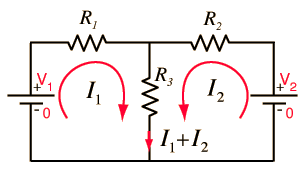Two Loop Currents
Application of the voltage law and the current law. This approach requires two simultaneous equations formed by applying the voltage law to both loops. Taking the loops in the directions shown means that the sum of the currents flows through the middle resistor. Putting polarities on each component helps to keep the signs straight. The two loop equations are:
  |
Subtracting (2) from (1) and solving for the currents gives:  |
Note: To avoid dealing with so many short circuits, any resistor with value zero will default to 1 when a voltage is changed. It can be changed back to a zero value if you wish to explore the effects of short circuits. Ohms and amperes are the default units, but if you put in resistor values in kilohms, then the currents will be milliamperes.
| Other approaches to two-loop circuits |
| Another example of voltage and current law use. |
DC Circuits
| HyperPhysics***** Electricity and Magnetism | R Nave |




